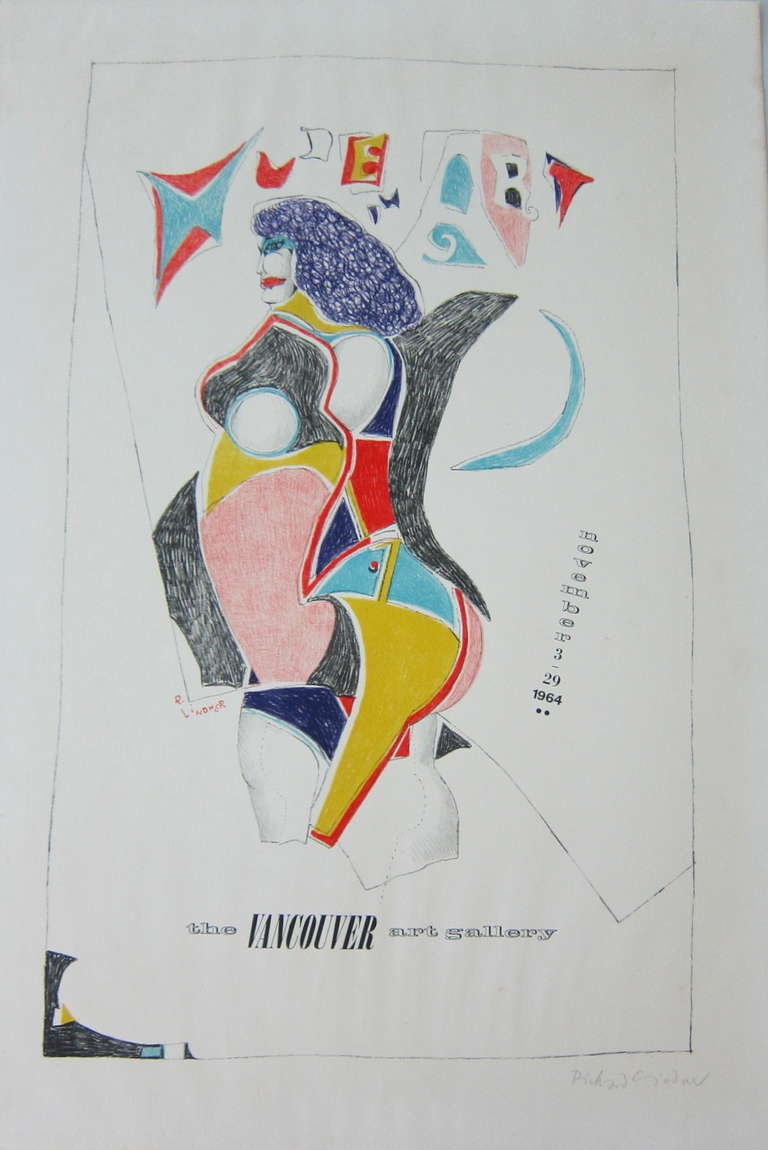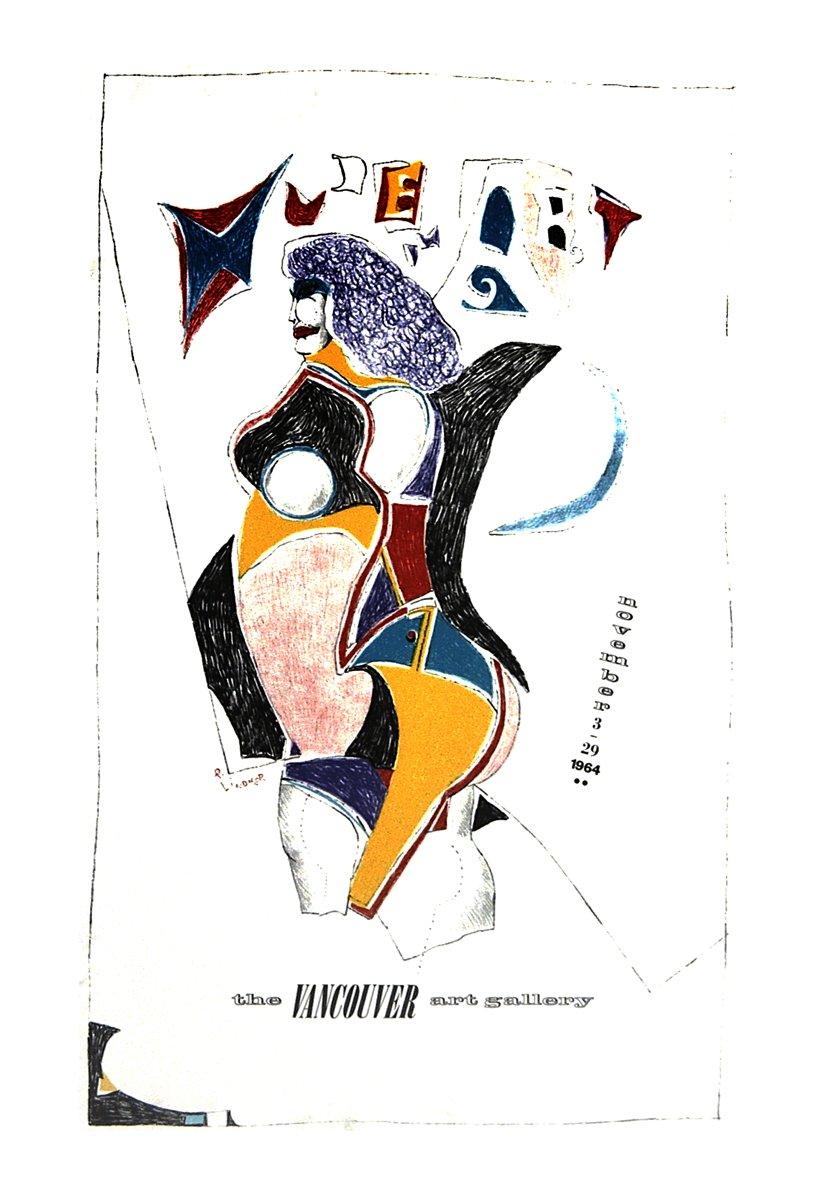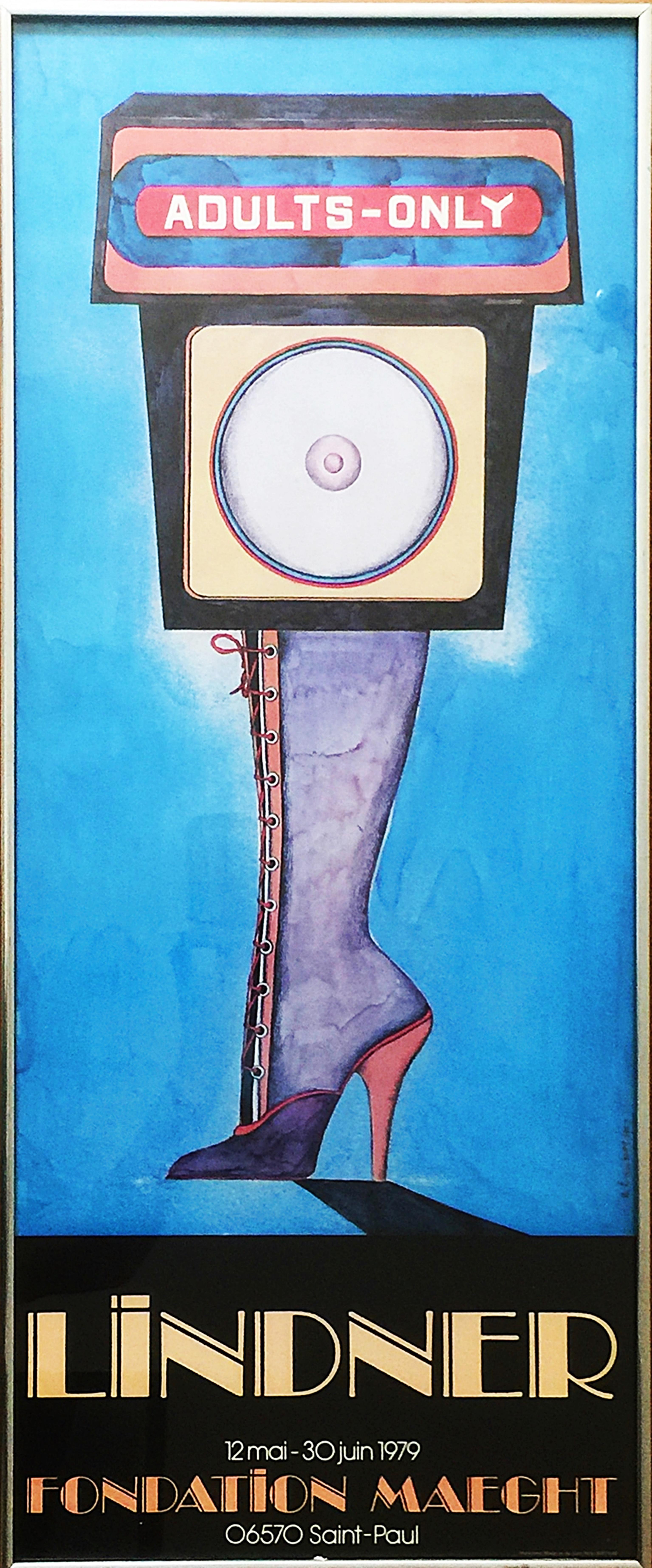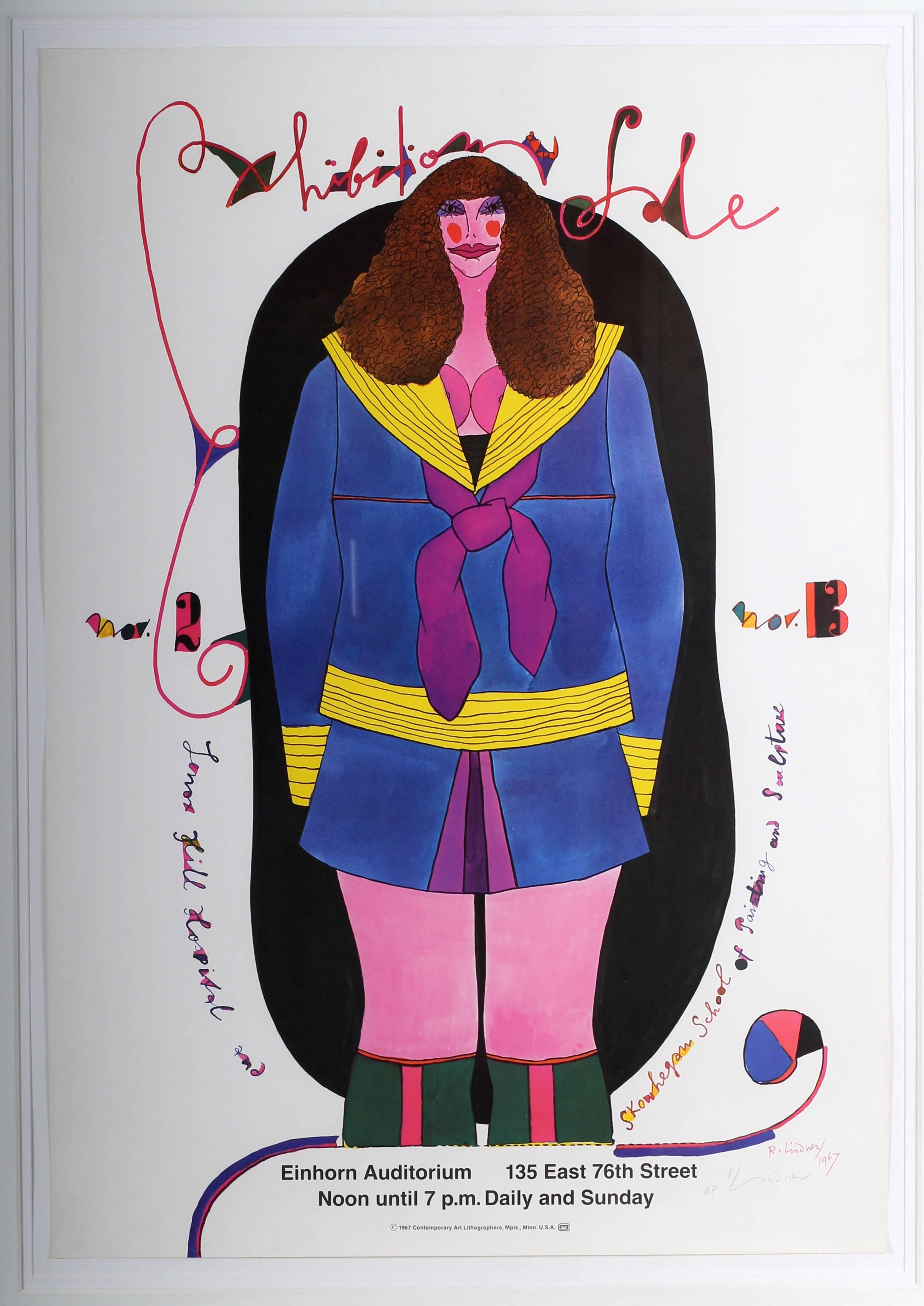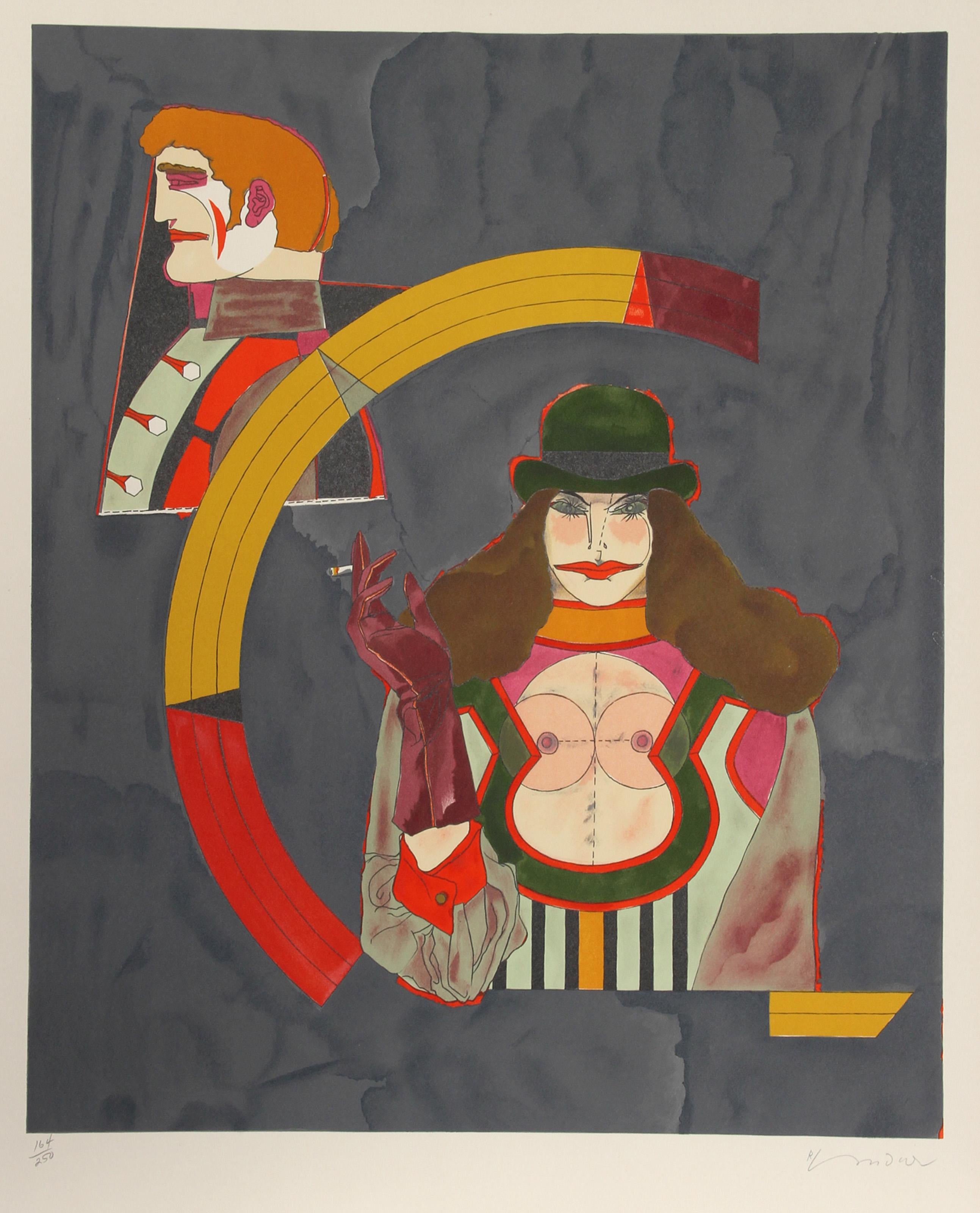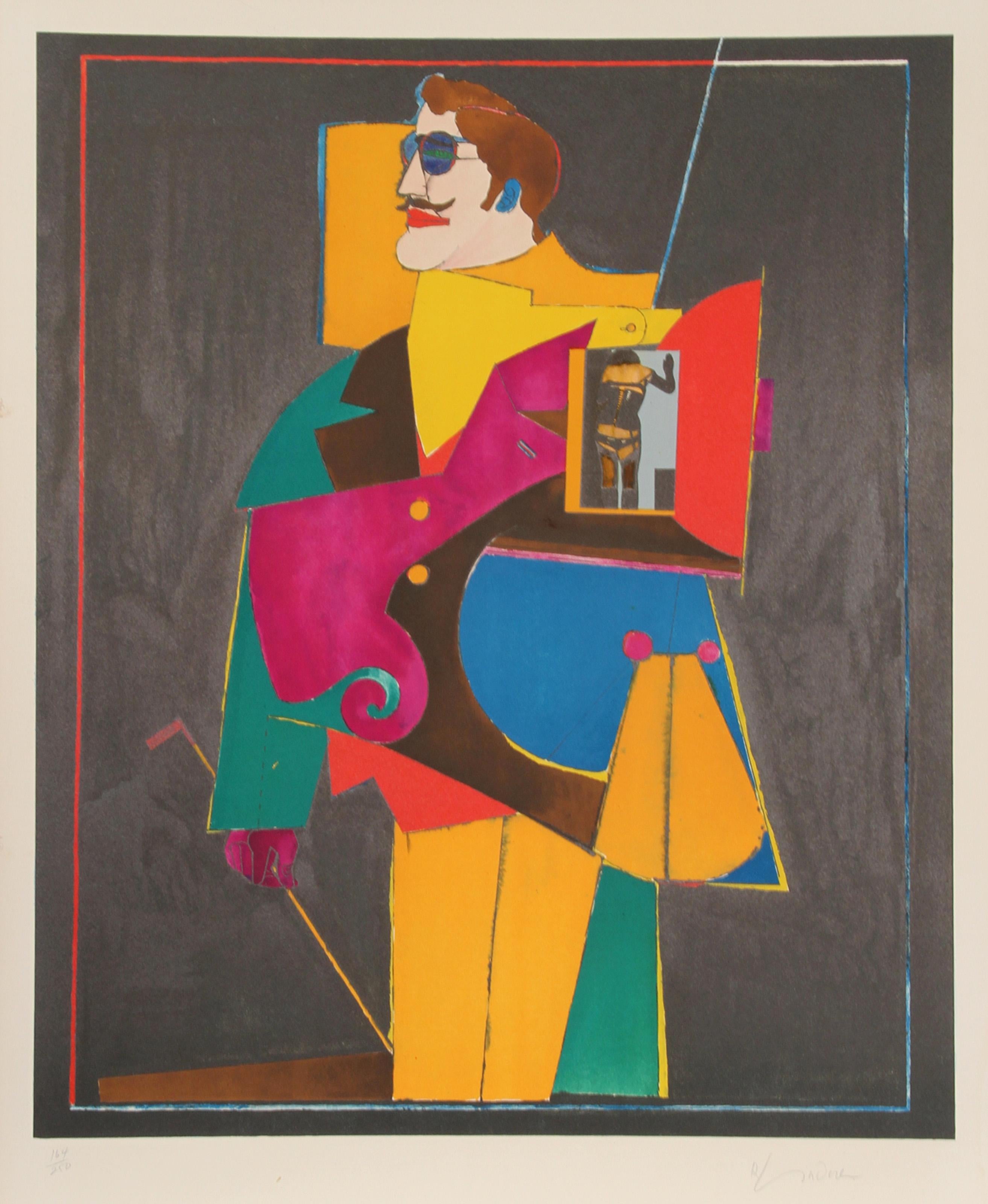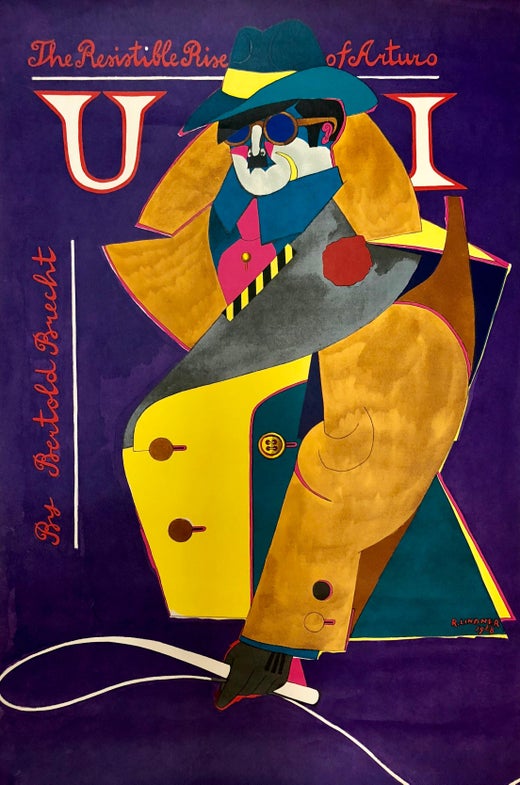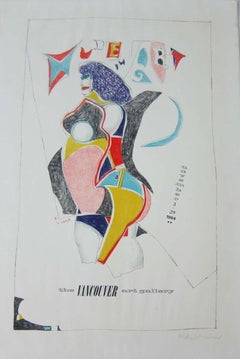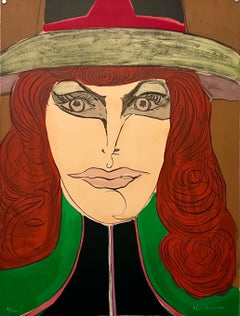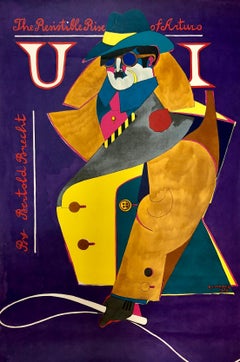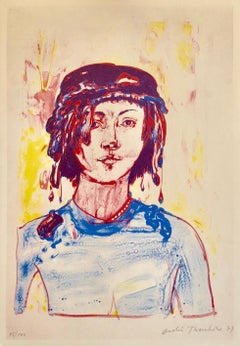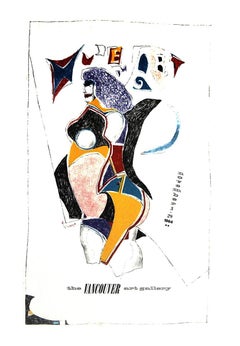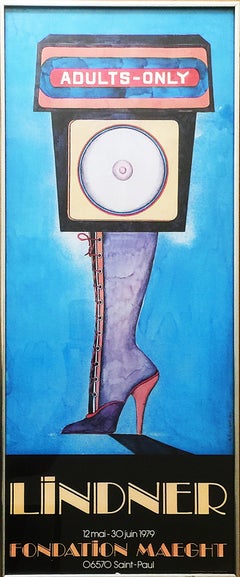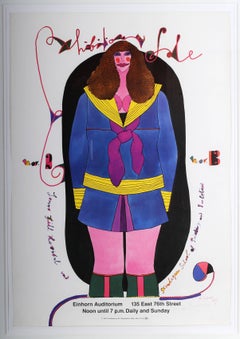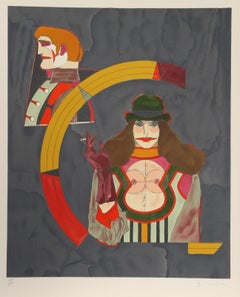Items Similar to Vintage Modern Lithograph Poster 1960s Pop Art Mod Figure
Want more images or videos?
Request additional images or videos from the seller
1 of 11
Richard LindnerVintage Modern Lithograph Poster 1960s Pop Art Mod Figure1964
1964
$500
£381.51
€434
CA$702.16
A$768.43
CHF 406.05
MX$9,171.74
NOK 5,181.69
SEK 4,739.08
DKK 3,241.76
About the Item
Vintage 1960's Lithograph poster for Vancouver Canada art show.
Richard Lindner was born in Hamburg, Germany. In 1905 the family moved to Nuremberg, where Lindners mother was owner of a custom-fitting corset business and Richard Lindner grew up and studied at the Kunstgewerbeschule (Arts and Crafts School since 1940 Academy of Fine Arts). From 1924 to 1927 he lived in Munich and studied there from 1925 at the Kunstakademie. In 1927 he moved to Berlin and stayed there until 1928, when he returned to Munich to become art director of a publishing firm. He remained there until 1933, when he was forced to flee to Paris, where he became politically engaged, sought contact with French artists and earned his living as a commercial artist. He was interned when the war broke out in 1939 and later served in the French Army. In 1941 he went to the United States and worked in New York City as an illustrator of books and magazines (Vogue, Fortune and Harper's Bazaar). He began painting seriously in 1952, holding his first one-man exhibit in 1954. His style blends a mechanistic cubism with personal images and haunting symbolism. LIndner maintained contact with the emigre community including New York artists and German emigrants (Albert Einstein, Marlene Dietrich, Saul Steinberg). Though he became a United States citizen in 1948, Lindner considered himself a New Yorker, but not a true American. However, over the course of time, his continental circus women became New York City streetwalkers. New York police uniforms replaced European military uniforms as symbols of authority.At a time when Abstract Expressionism was all the rage, Lindner’s painting went against the current and always kept its distance. His pictorial language of vibrant colours and broad planes of colour and his urban themes make him a forerunner of American Pop Art. At the same time, he owes the critical tone of his paintings to the influence of European art movements such as Neue Sachlichkeit and Dada. His first exhibition did not take place until 1954, by which time he was over fifty, and, interestingly, it was held at the Betty Parsons Gallery in New York, a venue associated with the American Expressionists. From 1952 he taught at the Pratt Institute, Brooklyn, from 1967 at Yale University School of Art and Architecture, New Haven. In 1957 Lindner got the William and Norma Copley Foundation-Award. In 1965 he became Guest Professor at the Akademie für Bildende Künste, Hamburg. His Ice (1966, Whitney Museum of American Art) established a connection between the metaphysical tradition and pop art. The painting shows harsh, flat geometric shapes framing an erotic but mechanical robot-woman.His paintings used the sexual symbolism of advertising and investigated definitions of gender roles in the media. While influencing Pop Art (Tom Wesselman and Claes Oldenburg amongst others) his highly colourful, hard-edge style seems to have brought him close to Pop Art, which he rejected. Nevertheless, he is immortalised on the cover of the Beatles record "Sgt. Pepper’s Lonely Hearts Club Band" (1967) as a patron of the pop culture.
- Creator:Richard Lindner (1901-1978, American)
- Creation Year:1964
- Dimensions:Height: 29 in (73.66 cm)Width: 20 in (50.8 cm)
- Medium:
- Movement & Style:
- Period:
- Condition:minor wear.
- Gallery Location:Surfside, FL
- Reference Number:1stDibs: LU38213716862
Richard Lindner
Richard Lindner (1901 – 1978) was a German-American painter. Lindner's mother was owner of a custom-fitting corset business and Richard Lindner grew up and studied at the Kunstgewerbeschule (Arts and Crafts School since 1940 Academy of Fine Arts). From 1924 to 1927 he lived in Munich and studied there from 1925 at the Kunstakademie. In 1927 Lindner moved to Berlin and stayed there until 1928, when he returned to Munich to become art director of a publishing firm. He remained in Munich until 1933, when he was forced to flee to Paris. Once in Paris, Lindner became politically engaged, sought contact with French artists and earned his living as a commercial artist. He was interned when World War II broke out in 1939 and later served in the French Army. In 1941, Lindner moved to the United States and worked in New York City as an illustrator of books and magazines. There he made contact with New York artists and German emigrants such as Albert Einstein, Marlene Dietrich, and Saul Steinberg. In 1948, Lindner became an American citizen. Lindner taught at a number of institutions including the Pratt Institute, Brooklyn, Hochschule fur bildende Kunste in Hamburg and Yale University School of Art and Architecture. His paintings often used the sexual symbolism of advertising and investigated definitions of gender roles in the media.
About the Seller
4.9
Platinum Seller
Premium sellers with a 4.7+ rating and 24-hour response times
Established in 1995
1stDibs seller since 2014
1,846 sales on 1stDibs
Typical response time: <1 hour
- ShippingRetrieving quote...Shipping from: Surfside, FL
- Return Policy
More From This Seller
View AllVintage Modern Lithograph Poster 1960s Pop Art Mod Figure Pencil Signed
By Richard Lindner
Located in Surfside, FL
Richard Lindner was born in Hamburg, Germany. In 1905 the family moved to Nuremberg, where Lindners mother was owner of a custom-fitting corset business and Richard Lindner grew up a...
Category
1960s Pop Art Abstract Prints
Materials
Lithograph
1971 Modernist Lithograph Redhead Pop Art Mod Fashionable Woman Richard Lindner
By Richard Lindner
Located in Surfside, FL
RICHARD LINDNER (American. 1901-1978)
Hand Signed limited edition lithograph with blindstamp
Publisher: Shorewood-Bank Street Atelier for the Skowhegan School of Painting and Sculpture
29.25 X 22 inches
Richard Lindner was born in Hamburg, Germany. In 1905 the family moved to Nuremberg, where Lindner's mother was owner of a custom-fitting corset business and Richard Lindner grew up and studied at the Kunstgewerbeschule (Arts and Crafts School since 1940 Academy of Fine Arts). From 1924 to 1927 he lived in Munich and studied there from 1925 at the Kunstakademie. In 1927 he moved to Berlin and stayed there until 1928, when he returned to Munich to become art director of a publishing firm. He remained there until 1933, when he was forced to flee to Paris, where he became politically engaged, sought contact with French artists and earned his living as a commercial artist. He was interned when the war broke out in 1939 and later served in the French Army. In 1941 he went to the United States and worked in New York City as an illustrator of books and magazines (Vogue, Fortune and Harper's Bazaar). He began painting seriously in 1952, holding his first one-man exhibit in 1954. His style blends a mechanistic cubism with personal images and haunting symbolism. LIndner maintained contact with the emigre community including New York artists and German emigrants (Albert Einstein, Marlene Dietrich, Saul Steinberg). Though he became a United States citizen in 1948, Lindner considered himself a New Yorker, but not a true American. However, over the course of time, his continental circus women became New York City streetwalkers. New York police uniforms replaced European military uniforms as symbols of authority.At a time when Abstract Expressionism was all the rage, Lindner’s painting went against the current and always kept its distance. His pictorial language of vibrant colours and broad planes of colour and his urban themes make him a forerunner of American Pop Art. At the same time, he owes the critical tone of his paintings to the influence of European art movements such as Neue Sachlichkeit and Dada. His first exhibition did not take place until 1954, by which time he was over fifty, and, interestingly, it was held at the Betty Parsons Gallery in New York, a venue associated with the American Expressionists. From 1952 he taught at the Pratt Institute, Brooklyn, from 1967 at Yale University School of Art and Architecture, New Haven. In 1957 Lindner got the William and Norma Copley Foundation-Award. In 1965 he became Guest Professor at the Akademie für Bildende Künste, Hamburg. His Ice (1966, Whitney Museum of American Art) established a connection between the metaphysical tradition and pop art. He did work on Rowlux which was used by a number of pop artists (most notably Roy Lichtenstein)The painting shows harsh, flat geometric shapes framing an erotic but mechanical robot-woman. His paintings used the sexual symbolism of advertising and investigated definitions of gender roles in the media. While influencing Pop Art (Andy Warhol, Tom Wesselmann and Claes Oldenburg amongst others) his highly colourful, hard-edge style seems to have brought him close to Pop Art, which he rejected. Nevertheless, he is immortalised on the cover of the Beatles record "Sgt. Pepper’s Lonely Hearts Club Band" (1967) as a patron of the pop culture. He also did a tapestry banner with the Betsy Ross Flag...
Category
1970s Pop Art Abstract Prints
Materials
Lithograph
Offset Lithograph Poster Resistible Rise of Arturo, Bertold Brecht 1968 Pop Art
By Richard Lindner
Located in Surfside, FL
Plate signed and dated, offset lithograph.
Richard Lindner was born in Hamburg, Germany. In 1905 the family moved to Nuremberg, where Lindners mother was owner of a custom-fitting corset business and Richard Lindner grew up and studied at the Kunstgewerbeschule (Arts and Crafts School since 1940 Academy of Fine Arts). From 1924 to 1927 he lived in Munich and studied there from 1925 at the Kunstakademie. In 1927 he moved to Berlin and stayed there until 1928, when he returned to Munich to become art director of a publishing firm. He remained there until 1933, when he was forced to flee to Paris, where he became politically engaged, sought contact with French artists and earned his living as a commercial artist. He was interned when the war broke out in 1939 and later served in the French Army. In 1941 he went to the United States and worked in New York City as an illustrator of books and magazines (Vogue, Fortune and Harper's Bazaar). He began painting seriously in 1952, holding his first one-man exhibit in 1954. His style blends a mechanistic cubism with personal images and haunting symbolism. LIndner maintained contact with the emigre community including New York artists and German emigrants (Albert Einstein, Marlene Dietrich, Saul Steinberg). Though he became a United States citizen in 1948, Lindner considered himself a New Yorker, but not a true American. However, over the course of time, his continental circus women became New York City streetwalkers. New York police...
Category
1960s Pop Art Abstract Prints
Materials
Lithograph, Offset
1970s Modernist Swiss Colorful Surrealism Signed Dada Lithograph Andre Thomkins
By André Thomkins
Located in Surfside, FL
This one is untitled and depicts a portrait of a young woman in yellow, red and blue with a Maryan like quality to it.
Published by Edition Hansjörg Mayer, Stuttgart They published concrete poetry and art books by Mark Boyle, Richard Hamilton, Dorothy Iannone, John Latham, Tom Phillips, Dieter Roth, André Thompkins and Emmett Williams, to name just a few.
André Thomkins (1930 - 1985) was a Swiss painter, illustrator, and poet. He attended art-school, taught by Max von Moos, 1947 – 1949 and the Académie de la Grande Chaumière, Paris, France, 1950. From 1952, he lived in Germany and taught at the Kunstakademie Düsseldorf between 1971 and 1973.
Thomkins painted and drew ironic and fantastic pictures influenced by surrealism and dadaism. Together with Dieter Roth and Daniel Spoerri he prepared works of Eat Art. He also was a writer of palindromes. His friends and collaborators included Daniel Spoerri, Dieter Roth, George Brecht, Richard Hamilton and Karl Gerstner, Thomkins gained a reputation as an ‘artist’s artist’, and is considered one of the most important Swiss artists of the second half of the twentieth century.He died in 1985.
His work is currently represented by Hauser & Wirth Zurich, Switzerland.
Select group exhibitions:
2018
Kunsthalle Krems, 'Pablo Picasso. Arshile Gorky, Andy Warhol. Sculptures and Works on Paper. Hubert Looser Collection', Krems, Austria
2017
Kunsthandel Wolfgang Werner, 'Martin Barré, Karl Otto Götz, Ernst Wilhelm Nay, André Thomkins',
Berlin, Germany
2013
Fabian & Claude Walter Galerie, 'Schweizer Avantgarde Kunst nach 1940', Zurich, Switzerland
2009
The Modern Institute, 'Thomas Houseago, Dieter Roth, Andre Thomkins', Glasgow, England
Museum of Modern Art, 'Compass in Hand: Selections from the Judith Rothschild Collection', NYC
2004
Kunsthandel Wolfgang Werner, 'Arman, Baumeister, Götz, Graubner, Tàpies, Thomkins', Berlin,
Germany
1994
Kunstmuseum Solothurn, 'Eine Schenkung. Grafik von Eduardo Chillida, Antoni Tàpies, Alexander Calder, Jean Dubuffet, Ben Nicholson, Giacometti, Tinguely, Thomkins', Solothurn, Switzerland
1992
Galerie Littmann, Tinguely zu Ehren. A Tribute to Jean Tinguely. Hommage à Tinguely, Basel,
1988
Museum Ludwig, 'Uebrigens sterben immer die anderen. Marcel Duchamp und die Avantgarde seit
1950', Cologne, Germany
1987
Aargauer Kunsthaus, 'Otto Grimm. Marc-Antoine Fehr. Christoph Gredinger', Aarau, Switzerland
Cercle Municipal, 'Art contemporain suisse. Collection de la Banque du Gothard', Luxembourg,
1985
Centre national d'art et de culture Georges Pompidou, 'Livres d'artistes', Paris, France
Rathaus, 'Claude Sandoz – Hans Schärer...
Category
1970s Dada Figurative Prints
Materials
Lithograph, Offset
1970s Modernist Swiss Colorful Surrealism Signed Dada Lithograph Andre Thomkins
By André Thomkins
Located in Surfside, FL
This one is titled "Halemaid" and depicts a surreal figure of a robed woman in yellow red and blue with a Salvador Dali esque quality about it.
Published by Edition Hansjörg Mayer, Stuttgart They published concrete poetry and art books by Mark Boyle, Richard Hamilton, Dorothy Iannone, John Latham, Tom Phillips, Dieter Roth, André Thompkins and Emmett Williams, to name just a few.
André Thomkins (1930 - 1985) was a Swiss painter, illustrator, and poet. He attended art-school, taught by Max von Moos, 1947 – 1949 and the Académie de la Grande Chaumière, Paris, France, 1950. From 1952, he lived in Germany and taught at the Kunstakademie Düsseldorf between 1971 and 1973.
Thomkins painted and drew ironic and fantastic pictures influenced by surrealism and dadaism. Together with Dieter Roth and Daniel Spoerri he prepared works of Eat Art. He also was a writer of palindromes. His friends and collaborators included Daniel Spoerri, Dieter Roth, George Brecht, Richard Hamilton and Karl Gerstner, Thomkins gained a reputation as an ‘artist’s artist’, and is considered one of the most important Swiss artists of the second half of the twentieth century.He died in 1985.
His work is currently represented by Hauser & Wirth Zurich, Switzerland.
Select group exhibitions:
2018
Kunsthalle Krems, 'Pablo Picasso. Arshile Gorky, Andy Warhol. Sculptures and Works on Paper. Hubert Looser Collection', Krems, Austria
2017
Kunsthandel Wolfgang Werner, 'Martin Barré, Karl Otto Götz, Ernst Wilhelm Nay, André Thomkins',
Berlin, Germany
2013
Fabian & Claude Walter Galerie, 'Schweizer Avantgarde Kunst nach 1940', Zurich, Switzerland
2009
The Modern Institute, 'Thomas Houseago, Dieter Roth, Andre Thomkins', Glasgow, England
Museum of Modern Art, 'Compass in Hand: Selections from the Judith Rothschild Collection', NYC
2004
Kunsthandel Wolfgang Werner, 'Arman, Baumeister, Götz, Graubner, Tàpies, Thomkins', Berlin,
Germany
1994
Kunstmuseum Solothurn, 'Eine Schenkung. Grafik von Eduardo Chillida, Antoni Tàpies, Alexander Calder, Jean Dubuffet, Ben Nicholson, Giacometti, Tinguely, Thomkins', Solothurn, Switzerland
1992
Galerie Littmann, Tinguely zu Ehren. A Tribute to Jean Tinguely. Hommage à Tinguely, Basel,
1988
Museum Ludwig, 'Uebrigens sterben immer die anderen. Marcel Duchamp und die Avantgarde seit
1950', Cologne, Germany
1987
Aargauer Kunsthaus, 'Otto Grimm. Marc-Antoine Fehr. Christoph Gredinger', Aarau, Switzerland
Cercle Municipal, 'Art contemporain suisse. Collection de la Banque du Gothard', Luxembourg,
1985
Centre national d'art et de culture Georges Pompidou, 'Livres d'artistes', Paris, France
Rathaus, 'Claude Sandoz – Hans Schärer...
Category
1970s Surrealist Figurative Prints
Materials
Lithograph, Offset
1970s Modernist Swiss Colorful Surrealism Signed Dada Lithograph Andre Thomkins
By André Thomkins
Located in Surfside, FL
This one is titled "Pissnake" It depicts a nude woman with a Niki de Saint Phalle style coiled snake. in pink, blue, red and yellow colors.
Published by Edition Hansjörg Mayer, Stuttgart They published concrete poetry and art books by Mark Boyle, Richard Hamilton, Dorothy Iannone, John Latham, Tom Phillips, Dieter Roth, André Thompkins and Emmett Williams, to name just a few.
André Thomkins (1930 - 1985) was a Swiss painter, illustrator, and poet. He attended art-school, taught by Max von Moos, 1947 – 1949 and the Académie de la Grande Chaumière, Paris, France, 1950. From 1952, he lived in Germany and taught at the Kunstakademie Düsseldorf between 1971 and 1973.
Thomkins painted and drew ironic and fantastic pictures influenced by surrealism and dadaism. Together with Dieter Roth and Daniel Spoerri he prepared works of Eat Art. He also was a writer of palindromes. His friends and collaborators included Daniel Spoerri, Dieter Roth, George Brecht, Richard Hamilton and Karl Gerstner, Thomkins gained a reputation as an ‘artist’s artist’, and is considered one of the most important Swiss artists of the second half of the twentieth century.He died in 1985.
His work is currently represented by Hauser & Wirth Zurich, Switzerland.
Select group exhibitions:
2018
Kunsthalle Krems, 'Pablo Picasso. Arshile Gorky, Andy Warhol. Sculptures and Works on Paper. Hubert Looser Collection', Krems, Austria
2017
Kunsthandel Wolfgang Werner, 'Martin Barré, Karl Otto Götz, Ernst Wilhelm Nay, André Thomkins',
Berlin, Germany
2013
Fabian & Claude Walter Galerie, 'Schweizer Avantgarde Kunst nach 1940', Zurich, Switzerland
2009
The Modern Institute, 'Thomas Houseago, Dieter Roth, Andre Thomkins', Glasgow, England
Museum of Modern Art, 'Compass in Hand: Selections from the Judith Rothschild Collection', NYC
2004
Kunsthandel Wolfgang Werner, 'Arman, Baumeister, Götz, Graubner, Tàpies, Thomkins', Berlin,
Germany
1994
Kunstmuseum Solothurn, 'Eine Schenkung. Grafik von Eduardo Chillida, Antoni Tàpies, Alexander Calder, Jean Dubuffet, Ben Nicholson, Giacometti, Tinguely, Thomkins', Solothurn, Switzerland
1992
Galerie Littmann, Tinguely zu Ehren. A Tribute to Jean Tinguely. Hommage à Tinguely, Basel,
1988
Museum Ludwig, 'Uebrigens sterben immer die anderen. Marcel Duchamp und die Avantgarde seit
1950', Cologne, Germany
1987
Aargauer Kunsthaus, 'Otto Grimm. Marc-Antoine Fehr. Christoph Gredinger', Aarau, Switzerland
Cercle Municipal, 'Art contemporain suisse. Collection de la Banque du Gothard', Luxembourg,
1985
Centre national d'art et de culture Georges Pompidou, 'Livres d'artistes', Paris, France
Rathaus, 'Claude Sandoz – Hans Schärer...
Category
1970s Dada Figurative Prints
Materials
Lithograph, Offset
You May Also Like
1964 After Richard Lindner 'Vancouver Art Gallery' Pop Art Multicolor Lithograph
By Richard Lindner
Located in Brooklyn, NY
Paper Size: 28.75 x 20 inches ( 73.025 x 50.8 cm )
Image Size: 25 x 15 inches ( 63.5 x 38.1 cm )
Framed: No
Condition: C: Several Signs of use and handling, some visible marks
...
Category
1960s Prints and Multiples
Materials
Lithograph
$100 Sale Price
20% Off
Richard Lindner, Adults-Only, Rare 1970s Pop Art poster in vintage frame Lt. Ed.
By Richard Lindner
Located in New York, NY
Richard Lindner
Adults-Only, 1979
Offset lithograph poster
Plate signature with date, right front
Limite Edition of 500 (unnumbered)
Frame Included: held in vintage 1970s metal perio...
Category
1970s Pop Art Figurative Prints
Materials
Lithograph, Offset
American Pop art artist, Richard Lindner exhibition poster
By Richard Lindner
Located in Petworth, West Sussex
Richard Lindner (German-American, 1901-1978)
An Art exhibition poster for Lennox Hill Hospital and Skowhegan School of painting and sculpture, 1967
Artist’s proof
Signed in pencil ‘R...
Category
Mid-20th Century Modern Figurative Prints
Materials
Lithograph
Portrait No. 2, Pop Art Lithograph by Richard Lindner
By Richard Lindner
Located in Long Island City, NY
Richard Lindner, German/American (1901 - 1978) - Portrait No. 2, Portfolio: After Noon Portfolio, Year: 1969, Medium: Lithograph on Arches, Signed and numbered in pencil, Edition:...
Category
1960s Pop Art Portrait Prints
Materials
Lithograph
The Heart, Pop Art Lithograph by Richard Lindner
By Richard Lindner
Located in Long Island City, NY
Richard Lindner, German/American (1901 - 1978) - The Heart, Portfolio: After Noon Portfolio, Year: 1969, Medium: Lithograph, signed and numbered in pencil, Edition: 250, Size: 2...
Category
1960s Pop Art Portrait Prints
Materials
Lithograph
An American Portrait, Pop Art Lithograph by Richard Lindner
By Richard Lindner
Located in Long Island City, NY
Richard Lindner, German/American (1901 - 1978) - An American Portrait, Year: 1976, Medium: Lithograph, signed and numbered in pencil, Edition: 89/178, Image Size: 21.75 x 16.5 in...
Category
1970s Pop Art Portrait Prints
Materials
Lithograph
More Ways To Browse
1960s Modern Art
1960S Vintage Posters
Retro 1960s Posters
Canada Poster
1960s Pop Posters
11 Pop Artists
Agam Agamograph
Alexander Calder Braniff
Anuszkiewicz Signed
Arthur Boyd
Ballet Russe Costume
Calder Print Sun
Cobra Art Signed
Dollar Bill Painting
Exhibition Poster 1984
Gagosian Poster
Georges Braque 1955
Henri Georges Adam
